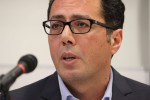Ottawa’s rewriting of the rules on government spending raises serious questions
A Canadian flag flies in front of the Peace Tower on Parliament Hill in Ottawa.Chris Wattie/Reuters
Clément Gignac is a Canadian senator. Patrick Leblond is an associate professor and holder of the CN-Paul M. Tellier Chair on Business and Public Policy at the University of Ottawa. Charles Asselin is a research assistant at the Senate of Canada.
The federal budget planned for this autumn is expected to account for public spending by separating current operations and long-term investments. This new framework proposed by Prime Minister Mark Carney marks a significant change in the way the government presents its fiscal policy.
According to Mr. Carney, this move will enable a more accurate presentation of the government’s financial situation. More importantly, this budgetary strategy is part of the government’s repositioning as an investor in Canada’s economic and security transformation.
The Liberal Party’s fiscal and costing plan for the recent federal election campaign said the new approach “will mean spending less on operations so we can invest more in the things that build Canada, like homes, naval ships, roads, and the capacity of businesses to invest in technology, production, and ideas.”
This new budgetary approach raises important questions: Will it strengthen fiscal discipline? What public spending qualifies as an investment? What supervisory mechanisms will guarantee transparency?
Consider the British Treasury, which has long distinguished between resource spending and capital spending.........






















 Toi Staff
Toi Staff Gideon Levy
Gideon Levy Somdeep Sen
Somdeep Sen Belen Fernandez
Belen Fernandez Tafi Mhaka
Tafi Mhaka Tarik Cyril Amar
Tarik Cyril Amar Dr Ramzy Baroud
Dr Ramzy Baroud Stephanie A. Sarkis Ph.d
Stephanie A. Sarkis Ph.d Sabine Sterk
Sabine Sterk Rachel Marsden
Rachel Marsden Ghada Ageel
Ghada Ageel Muhannad Ayyash
Muhannad Ayyash Sarah Tuttle-Singer
Sarah Tuttle-Singer John Nosta
John Nosta
